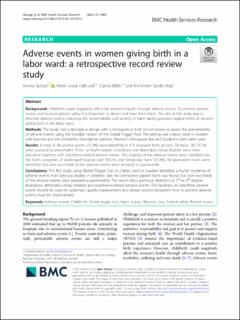| dc.contributor.author | Skoogh, Annika | |
| dc.contributor.author | Hall-Lord, Marie Louise | |
| dc.contributor.author | Bååth, Carina Barbro | |
| dc.contributor.author | Sandin-Bojö, Ann-Kristin | |
| dc.date.accessioned | 2022-10-20T13:29:34Z | |
| dc.date.available | 2022-10-20T13:29:34Z | |
| dc.date.created | 2021-10-29T16:22:00Z | |
| dc.date.issued | 2021 | |
| dc.identifier.citation | BMC Health Services Research. 2021, 21, Article 1093. | en_US |
| dc.identifier.issn | 1472-6963 | |
| dc.identifier.uri | https://hdl.handle.net/11250/3027354 | |
| dc.description.abstract | Background: Childbirth could negatively affect the woman’s health through adverse events. To prevent adverse events and increase patient safety it is important to detect and learn from them. The aim of the study was to describe adverse events, including the preventability and severity of harm during planned vaginal births, in women giving birth in the labor ward. Methods: The study had a descriptive design with a retrospective birth record review to assess the preventability of adverse events using the Swedish version of the Global Trigger Tool. The setting was a labor ward in Sweden with low-risk and risk childbirths. Descriptive statistics, Pearson’s Chi-square test and Student’s t-test were used. Results: A total of 38 adverse events (12.2%) were identified in 311 reviewed birth records. Of these, 28 (73.7%) were assessed as preventable. Third- or fourth-degree lacerations and distended urinary bladder were most prevalent together with anesthesia-related adverse events. The majority of the adverse events were classified into the harm categories of ‘prolonged hospital care’ (63.2%) and ‘temporary harm’ (31.6%). No permanent harm were identified, but over two-thirds of the adverse events were assessed as preventable. Conclusions: This first study using Global Trigger Tool in a labor ward in Sweden identified a higher incidence of adverse events than previous studies in obstetric care. No permanent patient harm was found, but over two-thirds of the adverse events were assessed as preventable. The results draw particular attention to 3rd-or 4th-degree lacerations, distended urinary bladder and anesthesia-related adverse events. The feedback on identified adverse events should be used for systematic quality improvement and clinical recommendations how to prevent adverse events must be implemented. | en_US |
| dc.language.iso | eng | en_US |
| dc.publisher | BioMed Central (BMC) | en_US |
| dc.rights | Navngivelse 4.0 Internasjonal | * |
| dc.rights.uri | http://creativecommons.org/licenses/by/4.0/deed.no | * |
| dc.subject | adverse events | en_US |
| dc.subject | childbirth | en_US |
| dc.subject | global trigger tool | en_US |
| dc.subject | harm | en_US |
| dc.subject | labor | en_US |
| dc.subject | obstetric care | en_US |
| dc.subject | patient safety | en_US |
| dc.subject | record review | en_US |
| dc.title | Adverse events in women giving birth in a labor ward: a retrospective record review study | en_US |
| dc.type | Peer reviewed | en_US |
| dc.type | Journal article | en_US |
| dc.description.version | publishedVersion | en_US |
| dc.rights.holder | © The Author(s). 2021. | en_US |
| dc.subject.nsi | VDP::Medisinske Fag: 700 | en_US |
| dc.source.volume | 21 | en_US |
| dc.source.journal | BMC Health Services Research | en_US |
| dc.identifier.doi | 10.1186/s12913-021-07109-5 | |
| dc.identifier.cristin | 1949758 | |
| dc.source.articlenumber | 1093 | en_US |
| cristin.ispublished | true | |
| cristin.fulltext | original | |
| cristin.qualitycode | 2 | |

